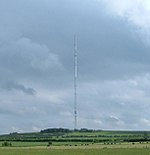Attborough Swallet
Caves of the Mendip Hills
Attborough Swallet (also known as Red Quar Swallet) is a cave in Chewton Mendip in Somerset, England. It is unusual for a cave on the Mendip Hills in that it is formed from Dolomitic Conglomerate and Marl rather than ordinary limestone. The main part of the cave was first entered in 1992, although Red Quar Swallet had been dug in the 1930s and the entrance shaft is now a concrete pipe.It takes its name from the Attborough field in which the entrance is situated. Red Quar Swallet comes from the small scale quarrying of red Triassic conglomerate.The underground stream feeding water into the sump flows into Wigmore Swallet.
Excerpt from the Wikipedia article Attborough Swallet (License: CC BY-SA 3.0, Authors).Attborough Swallet
B3135, Mendip Chewton Mendip
Geographical coordinates (GPS) Address Nearby Places Show on map
Geographical coordinates (GPS)
| Latitude | Longitude |
|---|---|
| N 51.2633 ° | E -2.6292 ° |
Address
B3135
BA5 3EX Mendip, Chewton Mendip
England, United Kingdom
Open on Google Maps









